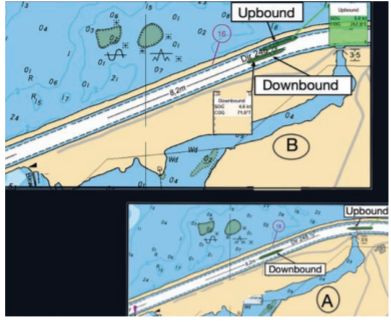202057 A tight squeeze goes wrong
As edited from official TSB (Canada) report M19C0387
The bridge teams of two vessels, one down-bound and one up-bound in a narrow channel, had agreed to meet just upstream from a curve. Some time later, while rounding the curve, the up-bound vessel proceeded close to the north bank and then deviated towards the centre of the canal, as in diagram A.
To correct the deviation, the bridge team altered course to starboard. Meanwhile, the down-bound vessel was approaching the curve at a speed of 4.9 knots with the current astern at about 1 knot. The vessel was positioned close to the centre-line of the channel and the Master made a VHF call to the up-bound vessel requesting more room. The up-bound bridge team did not acknowledge the call.
As the two vessels came abeam each other, as in diagram B, the up-bound vessel was slowly changing course to port, towards the centre of the channel. The down-bound vessel was still positioned close to the channel centre-line and maintaining its course. While manoeuvring, the up-bound vessel’s starboard quarter came within approximately 7m of the north bank of the channel and made bottom contact.

Lessons learned
- Meeting in very narrow channels takes special procedures whereby each vessel is on a steady course and almost pointed at the other. A successful meeting relies on bow pressure waves and hydrodynamics to keep the vessels apart.
- While it was mutually agreed to meet above the curve, the actual location of the meeting was arguably too close to the curve to give the up-bound vessel enough time to stabilise in a correct meeting posture. l Once the stern of a vessel becomes close to a bank, hydrodynamic suction (bank suction) will bring the stern even closer and make bottom contact hard to avoid.
